Kitesurfing Lessons in Charleston, SC: A Comprehensive Guide


Intro
Kitesurfing stands as one of the most exhilarating water sports, especially when celebrated in the stunning locales of Charleston, SC. The wind whipping through your hair, the rush of the waves beneath your feet—it’s a call to adventure that beckons many. However, for beginners, diving headfirst into this sport can seem daunting. That's where kitesurfing lessons come into play, providing essential knowledge and hands-on experience that transforms novices into confident riders.
In this guide, we’ll delve into various aspects of kitesurfing lessons tailored for Charleston's unique environment. We’ll discuss the importance of choosing the right kitesurfing school, the structure of lessons, and key considerations like local weather and safety regulations. Furthermore, we'll cover the must-have gear and top kiting spots in the area. By the end, you’ll be equipped with the insights needed to enhance your kitesurfing journey, whether you're just starting out or looking to refine your skills.
Gear Selection
Choosing the right gear can make a world of difference in your kitesurfing experience. It's not just about getting the flashy equipment—understanding the mechanics and styles behind kites and boards is crucial.
Types of Kites
When it comes to kites, you'll primarily encounter two main types: inflatable kites and foil kites.
- Inflatable Kites: Often considered more user-friendly, these kites are ideal for beginners. They provide stability, are easy to relaunch after a fall, and cater well to a variety of wind conditions.
- Foil Kites: These kites are excellent for their efficiency and performance, but they can be a tad tricky for novices. Foil kites are designed for specific wind conditions and may need more skill to handle.
Selecting a kite usually hinges on the wind conditions of the day and your own weight. A lighter person might opt for a smaller kite to gain better control and maneuverability, while heavier riders may require more substantial kites for adequate lift.
Choosing the Right Board
Much like kites, boards come with varying designs—each serving a different purpose.
- Directional Boards: Perfect for those who favor surfing-style riding, these boards excel in wave conditions. They allow for splendid downwind action and carve smoothly on the water.
- Twin-Tip Boards: This type of board is exceptionally common among beginners. They’re symmetrical and can be ridden in either direction, making them versatile and easy to learn with.
When selecting a board, consider your skill level, the type of riding you intend to do, and your weight. Lighter riders might find a shorter board easier to manage, while heavier riders should look for something with more volume for buoyancy.
Remember: Investing in quality gear pays off in the long run. It can significantly boost your learning curve and provide the comfort needed on the water.
Skill Development
While gear is pivotal, skill development is what will elevate your kitesurfing from basic to breathtaking. Much of learning revolves around understanding essential techniques and practicing effectively.
Essential Techniques
Whether just starting out or aiming to polish your skills, focus on the following techniques:
- Body Dragging: This technique involves being pulled through the water by your kite. It’s a must-know for handling crashes and relaunching.
- Water Starting: Mastering how to get on your board while maintaining control of the kite can feel like a rite of passage in kitesurfing.
Practicing these techniques repeatedly is crucial, and they are best learned under expert supervision.
Progression Tips
To refine your kitesurfing abilities:
- Stay Consistent: Regular practice helps solidify skills and builds muscle memory.
- Seek Feedback: Don’t shy away from asking instructors for pointers; they can offer insights that will quicken your learning.
- Observe and Adapt: Watch other kitesurfers and learn from their techniques. Adapting different styles can lead to improvements in your own skills.
Incorporating these aspects during your lessons can enhance your journey in kitesurfing, ensuring you ride at your best.
As you embark on your kitesurfing adventure in Charleston, remember to enjoy the process and the learning journey it entails. Knowledge is not just power; it's your ticket to embracing this thrilling sport well!
Preface to Kitesurfing
Kitesurfing stands as one of the most exhilarating water sports, effectively blending aspects of surfing, windsurfing, and paragliding. In Charleston, South Carolina, kitesurfing offers not just a thrilling experience but also a means to connect with nature and foster community among enthusiasts. Understanding the ins and outs of this sport is crucial for anyone looking to dive in, from curious newcomers to seasoned riders keen on refining their skills. The introduction will unpack the essentials of kitesurfing and lay the groundwork for the exciting journey ahead.
Understanding the Sport
At its core, kitesurfing involves riding on a board while harnessed to a large kite that is flown to harness wind power. This dynamic interaction between the kite and the rider creates an adrenaline-fueled experience that is hard to match. Motions are quite fluid, with navigating the water relying on a combination of skill and intuition. The sport is not simply about catching waves; it's a delicate dance of adjusting the kite’s position, mastering the wind, and ensuring balance on the board.
Each element of kitesurfing usually has its own learning curve, which can be a bit daunting for beginners. However, the rewards are immense. Once you grasp the basics, you quickly unlock the potential for jumps, tricks, and even long-distance riding. Whether you're eyeing the shoreline while relaxing at Folly Beach or looking to catch the wind near the Charleston Harbor, kitesurfing thrives in these picturesque locales.
Evolution of Kitesurfing
The history of kitesurfing isn't as straightforward as it might seem. Its roots trace back to the late 13th century with the earliest users employing large kites for transportation and fishing. Fast-forward to the early 1990s, kitesurfing began taking form as we know it today. Initially, riders relied on simple equipment, with frameworks and techniques that were often less than reliable. As the sport gained popularity, advancements in kite technology expanded possibilities significantly.
One pivotal moment came when manufacturers started producing inflatable kites, which enhanced buoyancy and stability, making kitesurfing much more accessible to the public.
By the turn of the century, the sport was being embraced globally, with the Charleston community soon catching the kitesurfing wave. Local riders began to experiment with personalized setups, making their own modifications to enhance performance and safety. Once viewed as a niche pastime, kitesurfing has now transformed into a flourishing global phenomenon, with competitions and communities blossoming in coastal cities worldwide.
As we dive deeper into the details of kitesurfing lessons available in Charleston, it becomes apparent that understanding the sport's fundamental aspects helps everyone appreciate the learning experience. Gaining insight into how kitesurfing evolved also enhances respect for the equipment and the skill involved, paving the way for a safer and more enjoyable adventure.
Kitesurfing in Charleston: Overview
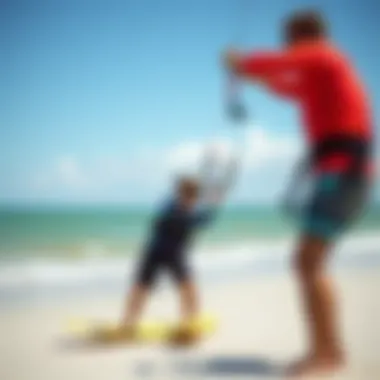
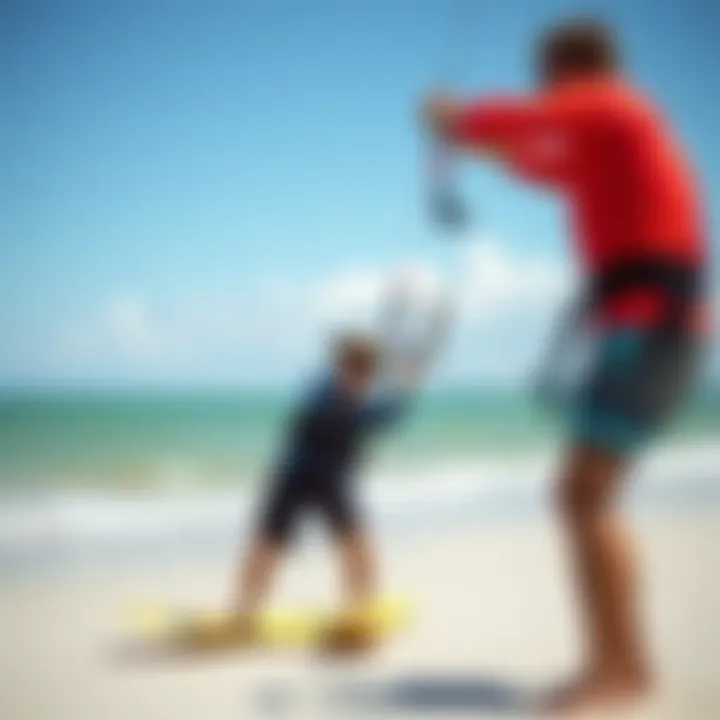
Kitesurfing in Charleston has gained a reputation that's hard to ignore. Combine the scenic beauty of the coast with an engaging sport, and you get the ideal setting for kiteboarders of all levels. The essence of this overview is to illustrate the unique position Charleston holds as a kitesurfing destination and how it benefits enthusiasts, from beginners taking their first steps to seasoned veterans wanting to refine their skills.
Geographical Advantages
Charleston occupies a prime spot along the coast of South Carolina, with a unique blend of diverse waterways and wind conditions. The area features estuaries, beaches, and flat water spots that cater to different kitesurfing styles. The wind, often blowing consistently, is largely favorable for kitesurfing, especially during spring and fall when breezes tend to pick up. These geographical attributes allow kiteboarders to experiment with various techniques and styles, enhancing their learning experiences.
You might find places like Folly Beach where the ocean meets the marshlands, creating a beautiful backdrop while enjoying those exhilarating rides. Locals often say that these waters are ideal for practicing jumps and tricks, attributing their skills to the forgiving nature of the flat water around the inlets.
- Marshlands and Inlets: Ideal for beginners and intermediate riders.
- Open Ocean Spots: Perfect for those seeking a challenge.
- Convenient Access: With various launching points around the city, the opportunity to kitesurf is never too far away.
Local Weather Patterns
To fully grasp the kitesurfing scene in Charleston, understanding the local weather patterns is essential. Charleston boasts a markedly humid subtropical climate, ideal for year-round kiteboarding, with distinct seasons playing an integral role in wind conditions.
- Spring and Fall: These months are often the most favorable. Winds tend to be more consistent, making them prime times for kitesurfing. The temperatures are comfortable, usually hovering between the mid-60s and mid-80s.
- Summer: Expect warmer temperatures, ranging from the mid-70s to low 90s, but winds can be less predictable. However, many still flock to the local waters to enjoy the beautiful weather.
- Winter: The winds can be brisk and the temperatures cooler. However, the die-hard kiteboarders still find solace and fun on the water, donning wetsuits to handle the chill.
To conclude, the geographical and meteorological traits of Charleston contribute significantly to its charm as a kitesurfing destination. Whether you're learning the ropes or looking for strong winds and big waves, Charleston offers all that and more. It’s a community united by the love of the sport, ready to welcome newcomers and seasoned riders alike.
Choosing a Kitesurfing School
Selecting a kitesurfing school may seem like a minor task, but it's a critical step that can greatly influence your overall experience and success in the sport. In Charleston, SC, where winds dance with the waves and stunning coastlines beckon, finding the right school is essential to harness the thrill of kitesurfing safely and effectively. A school worth its salt will not only teach you the fundamental skills needed to ride the waves but also instill confidence and foster an appreciation for the sport itself.
When it comes down to it, you're not just choosing a place to learn; you're investing in your kitesurfing journey. The right school can catapult you from a novice, clumsily floundering in the water, to a skilled rider gliding with the wind. Hence, it’s paramount to consider several elements:
- Accreditation and Certifications: Ensure the school is recognized by reputable organizations such as the International Kiteboarding Organization (IKO) or the British Kitesports Association (BKSA). This confirms that the school meets specific safety and instructional standards.
- Variety of Courses: A good school will offer a range of lessons from beginner to advanced levels. This ensures a continuum of learning where you can progress at your own pace.
- Equipment Accessibility: Look for schools that provide well-maintained gear. This is particularly crucial for beginners who may not yet own their equipment. Using quality gear ensures a safer and more enjoyable experience.
Choosing the right school can be the difference between enjoying your time on the water and feeling overwhelmed or frustrated. Therefore, taking the time to research and make an informed decision is critical.
Evaluating Credentials
When evaluating a kitesurfing school, the first step is to scrutinize their credentials. The presence of licenses and certifications not only showcases their professionalism but also reflects their commitment to uphold the safety and standards of kitesurfing. You can ask questions such as:
- What certifications do your instructors hold? This gives insight into their training and ability to instruct effectively.
- Are there any safety protocols in place? A solid school will outline their safety measures and how they maintain a safe learning environment.
Additionally, researching the school's reputation can provide a clearer picture.
- Check their website or local forums for information.
- Visit platforms such as Reddit or Facebook groups to gather firsthand accounts from other kitesurfers.
Instructors’ Experience
An instructor's experience can make or break your learning process in kitesurfing. These individuals are not just teachers; they are your guides into the exhilarating world of kiteboarding. Ask potential schools about:
- Years of experience: A seasoned instructor often translates into better teaching and quicker learning. They’ve likely encountered a range of student abilities and can adapt their approach accordingly.
- Personal kitesurfing background: Instructors who have participated in competitions or have extensive knowledge about the sport may offer unique insights that enrich your learning experience.
- Teaching style: Does the instructor take a hands-on approach, or do they prefer a laid-back style? Understanding their approach can help you decide if it aligns with your learning preferences.
The right instructor not only teaches you the skills needed but also inspires a passion for the sport, shaping your future adventures on the water.
Customer Reviews and Testimonials
Customer reviews can be a valuable resource in making your decision. They provide a snapshot of other learners’ experiences and can reveal both strengths and weaknesses of a school. When reading reviews, consider:
- Consistency in feedback: If multiple students highlight the same positive aspects, it likely represents a genuine strength of the school.
- Recent reviews: Kitesurfing schools can evolve, and recent testimonials will give you the latest insight into their operations and ensure they are up to date with current safety practices.
- Constructive criticisms: Look at how the school responds to feedback. A school that takes reviews seriously and seeks to improve is likely a good choice.
Remember, diving into reviews isn’t just about the scores; it’s about the stories and experiences surrounding them. Positive narratives combined with constructive critiques often provide a holistic view of what the school offers.
Choosing a suitable kitesurfing school in Charleston, SC, is not just about checking boxes; it's about ensuring a well-structured learning path that respects safety, nurtures skill development, and promotes a deep-seated love for the ocean and the sport. Take your time, do thorough research, and you're bound to find a place that aligns with your aspirations and safety considerations.
Structure of Kitesurfing Lessons
When stepping into the world of kitesurfing, understanding the structure of lessons is crucial for ensuring a fruitful learning journey. This framework not only outlines the pathway to mastering the sport, but it also enhances the overall experience, allowing individuals to progress at their own pace while addressing their unique needs. The structure of kitesurfing lessons in Charleston is designed with the factors that affect learning in mind, from skill level to safety.
Beginner's Lesson Breakdown
For those new to the sport, beginner lessons are often the foundation upon which everything else is built. These sessions usually cover the following elements:
- Theory Introduction: Instructors begin by explaining essential safety protocols, wind theory, and how to control the kite. This initial theoretical part helps novices understand the mechanics behind their movements.
- Basic Kite Control: Following the theory, learners get hands-on with a trainer kite. This smaller version allows individuals to practice flying techniques in a safe environment, building their confidence.
- Water Introduction: Once comfortable with the kite, the transition from land to water commences, often starting with body dragging. This stage is crucial, where learners experience the sensation of being pulled by the kite while maneuvering in the water.
- Board Basics: As students advance, they progress to standing on the board. Instructors focus on getting students up on their boards for the first time. This experience can be challenging; thus, encouragement and tailored guidance are essential.
The entire beginner's lesson is structured to guide students from the basics to being ready to ride, fostering both skill and safety.
Intermediate to Advanced Classes
Once the basics are mastered, students often seek to refine their kitesurfing skills through intermediate and advanced classes. These lessons tend to focus on:
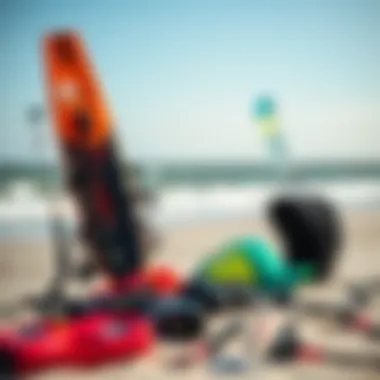
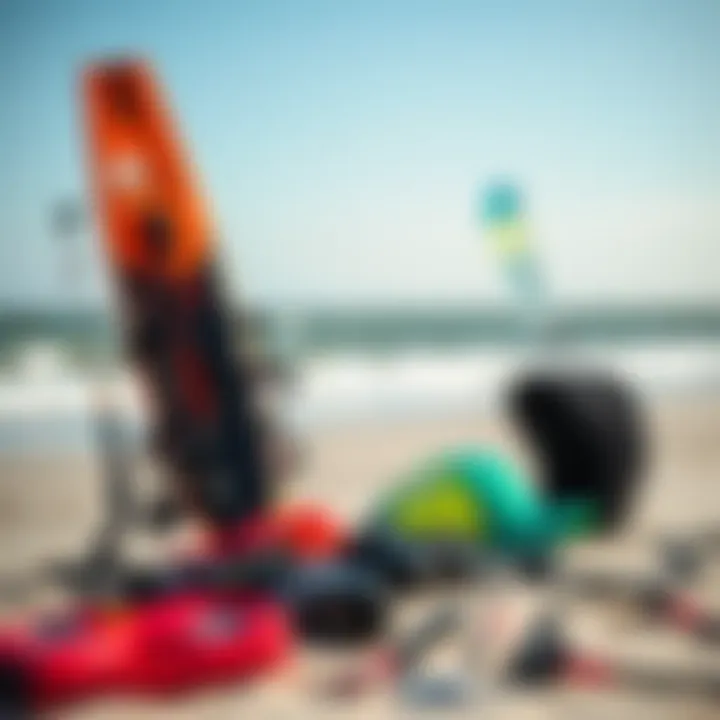
- Advanced Maneuvers: Those ready for the next step can learn tricks and techniques, such as jumps, spins, and transitions. Each maneuver requires a solid understanding of kite control and body positioning, building on what has been learned in earlier lessons.
- Condition Adaptation: Students learn to adapt to various wind and water conditions, which is vital for enhancing kitesurfing skills. Understanding how to read the environment allows kiteboarders to choose the best conditions for their rides.
- Personalized Coaching: Instructors adjust their teaching methods based on individual progress and style. This one-on-one attention helps to address specific weaknesses and to fine-tune skills, ensuring continued improvement.
Private vs Group Lessons
An important consideration for aspiring kiteboarders is choosing between private lessons and group classes. Each option has its merits:
- Private Lessons:
- Group Lessons:
- Tailored instruction to individual needs.
- Flexible scheduling to fit personal availability.
- Enhanced focus on specific skills or fears that might impede progress.
- Cost-effective, as the price is often distributed among attendees.
- Opportunities for social interaction, making learning more fun.
- Learning from peers can foster a supportive environment and motivate continued practice.
Ultimately, the decision should be based on learning style, budget, and personal goals. Regardless of the choice between private or group lessons, each structure is laid out to facilitate the growth and enjoyment of the sport.
"Whether you choose private or group lessons, what's most important is to find a teaching style that resonates with you!"
In summary, the structure of kitesurfing lessons in Charleston is thoughtfully designed to cater to various skill levels while prioritizing safety and enjoyment. The journey from a novice to a skilled kiteboarder is paved with well-organized lessons that allow for individual progress while embracing the thrill and beauty of the sport.
Essential Gear for Kitesurfing
When diving into kitesurfing, the gear you choose can make or break your experience on the water. Selecting the right equipment requires an understanding of what you need to stay safe while enjoying this thrilling sport. Each piece of gear plays a crucial role in not only performance but also in ensuring your safety. Let's closely examine the essential components of kitesurfing gear, as well as their benefits and key considerations.
Selecting Your Kite
Choosing the right kite hinges on several factors, including your weight, skill level, and wind conditions. Kites come in diverse shapes and sizes, each tailored for specific conditions.
- Types of Kites: There are generally two main types—inflatable kites and trainer kites. Inflatable kites provide better performance, while trainer kites are ideal for beginners learning the basics.
- Size Factor: A larger kite catches more wind, making it suitable for light wind days, while smaller kites perform better in stronger winds. Finding the right balance is essential to optimizing your experience.
Remember, a kite that suits one person may not be the best option for another, so it's worth speaking with instructors about what works best in Charleston's specific conditions.
Importance of a Proper Board
Just as important as the kite is the board itself. A proper board contributes significantly to your control and comfort.
- Board Types: There are directional boards and twintip boards. Directional boards, akin to surfboards, are often used in wave riding, while twin-tips are favored by freeride enthusiasts. Each has its learning curve and is suited to different riding styles.
- Size and Shape: The size of the board must correlate with your skill level and weight. A heavier rider may require a larger board for stability, while lighter riders might prefer smaller boards for maneuverability.
Ultimately, the right board can transform your riding experience, enhancing your skills and providing greater enjoyment out on the water.
Safety Equipment Essentials
Safety should never take a backseat in kitesurfing. Essential safety gear is crucial for mitigating risks and ensuring a secure outing.
- Helmet: A good-quality helmet protects your head from potential falls or collisions with equipment and helps prevent serious injuries.
- Impact Vest: Wearing an impact vest can protect your torso from falls and provide additional buoyancy in case of emergencies.
- Life Jacket: This is especially important for beginners and those venturing into deeper waters, ensuring you stay afloat if anything goes awry.
- Safety Leash: A quality safety leash prevents you from losing your kite in the water and keeps control as you work to recover from a tumble.
"In kitesurfing, being proactive about safety can turn a thrilling ride into an enjoyable adventure rather than a dangerous gamble."
Choosing the right gear for kitesurfing is a step toward mastering the sport while prioritizing safety in every aspect. Each component—your kite, board, and safety equipment—should be thoughtfully selected to enhance your skills and keep your good times rolling on the waves. Equip yourself wisely to savor each moment in Charleston's enlightening waters as you embark on this wonderful journey.
Safety Protocols in Kitesurfing
Kitesurfing, while exhilarating, carries its share of risks. This makes safety protocols an essential component of the sport. Like a lighthouse guiding vessels in a storm, proper safety practices help navigate the challenges that come with kitesurfing. Let’s dive into the heart of the matter—understanding how risk management and being prepared for emergencies can truly create a safer kitesurfing experience.
Understanding Risk Management
Risk management in kitesurfing is paramount. It ensues not just from practicing skills on the water but also from recognizing potential hazards before they arise. This includes environmental aspects, equipment checks, and personal limits. To create a safety-centric kitesurfing experience, consider these key elements:
- Environmental Awareness: Knowing the water conditions, tides, and weather patterns can be a game-changer. For example, strong currents or gusty winds can change the difficulty level of a session significantly.
- Gear Inspections: Before heading out, one must examine the kite, lines, harness, and board. A small tear in the canopy or frayed line can lead to catastrophic failures, turning a joyful ride into a dangerous situation.$
- Skill Evaluation: Understand your own skill level. Just because you can ride doesn’t mean you should tackle advanced conditions. If you’re unsure, it’s better to practice in calmer waters or seek lessons.
By being aware of what surrounds you and your gear, the odds of facing critical issues drastically decrease, transforming risk into enjoyment.
Emergency Procedures
Despite the best precautions, emergencies can still happen on the water. Having a well-thought-out plan can make all the difference. Here are some emergency procedures every kitesurfer should know:
- Signal for Help: If you find yourself in trouble, use your kite to signal for help. A kite raised high can attract attention very quickly, foiling any doom that might be looming.
- Know How to Self-Launch and Self-Land: These skills are crucial for navigating out of tricky situations. Practicing these techniques can mean the difference between getting away safely or being stuck in potentially dangerous waters.
- Remain Calm: In emergencies, panic can lead to poor decision-making. Taking a deep breath and evaluating your options can help steer you back on course.
- Escape with Your Equipment: If you must abandon the kite, ensure you’re safely detached. Letting it go will free you to swim to shore.
- Learn First Aid: Having basic first aid skills, especially knowledge of CPR, can empower you to act decisively in case of an injury.
"A proactive approach to safety is less about fearing the unknown and more about enjoying the ride, come rain or shine."
Grasping these emergency protocols fosters confidence among kitesurfers. Having effective plans enables a ride that’s not just thrilling but also safe, instilling a sense of community trust that can heighten the kitesurfing experience for everyone involved.
Environmental Considerations
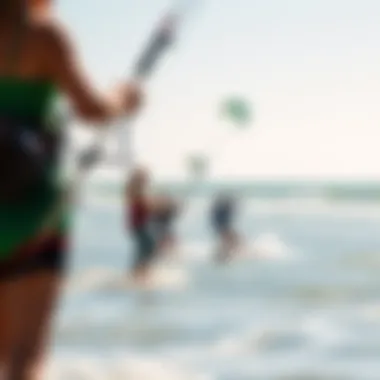
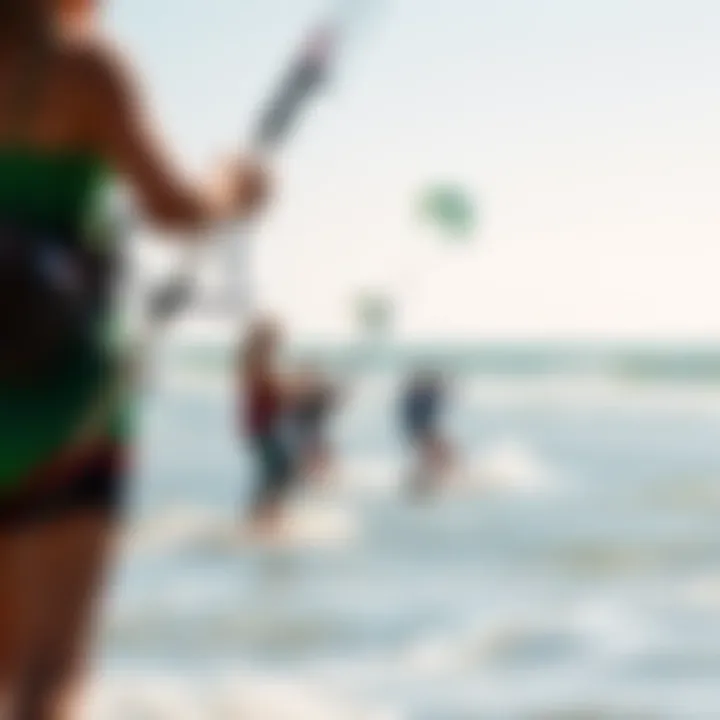
Engaging in kitesurfing means more than just harnessing the wind and cutting through the water; it also calls for a keen awareness of our surroundings. The environmental considerations associated with kitesurfing are crucial for preserving the beauty of Charleston's coastlines and ensuring the long-term sustainability of this exhilarating sport. As such, recognizing our environment and adapting to it creates a responsible kitesurfing community, vital for both present and future enthusiasts.
Preserving Kiteboarding Locations
Charleston’s stunning beaches and waterways provide the perfect backdrop for kitesurfing, yet they require proper care to maintain their ecological balance. Unique ecosystems thrive along the coast, from salt marshes to dune systems. To protect these places, kitesurfers ought to respect designated areas for launching and riding. Often, local regulations specify which spots are suitable for kitesurfing activity, and staying within these areas can help minimize disruptions to wildlife habitats.
Another aspect of preserving kiteboarding locations involves being aware of sensitive times in the environment. For instance, many birds migrate seasonally, and their nesting periods often coincide with prime kitesurfing months. Taking a moment to assess the activity and patterns around specific kitesurfing sites can keep our feathered friends safe and secure while still indulging in the sport we cherish.
- Identify and avoid nesting sites during key times.
- Follow local guidelines regarding access to kiteboarding locations.
- Engage with local conservation efforts for waterside protection.
"The clean, unspoiled nature of our kiteboarding spots is a gift, and it’s our responsibility to ensure they remain vibrant and thriving for everyone to enjoy."
Sustainable Kiteboarding Practices
While thrill-seekers chase after the next wave, sustainability shouldn’t take a back seat. Implementing environmentally friendly practices within kitesurfing can significantly impact the preservation of Charleston's coastlines. Here are some sustainable approaches to consider:
- Choose Eco-Friendly Gear: Many brands are shifting towards sustainable materials in their construction of kites and boards, striving to reduce their carbon footprint.
- Participate in Clean-Up Initiatives: Joining local or organized beach clean-up activities not only beautifies the environment but also fosters community spirit among kitesurfers.
- Educate Fellow Kitesurfers: Share knowledge about sustainable practices and the importance of keeping our environment clean to fellow enthusiasts.
Prioritizing sustainable practices ensures that Charleston's stunning kitesurfing locations can be enjoyed by generations to come. Therefore, every kiteboarder should embrace their role as stewards of the environment. This attitude will allow us to enjoy the thrill of riding the wind while fostering appreciation for the natural world around us.
Kitesurfing Community in Charleston
The vibrant kitesurfing community in Charleston, South Carolina, plays a pivotal role in fostering both the sport and the culture surrounding it. With a growing number of enthusiasts, the local scene isn't just about the thrill of gliding across the water; it's also about connection, support, and shared experiences that elevate the kitesurfing journey.
The importance of a community in any sport cannot be overstated. In kitesurfing, especially, where conditions can change rapidly and safety is paramount, having a network of fellow kiteboarders can provide invaluable support. From sharing advice on the best spots to practice your tricks, to providing assistance during those less-than-glamorous wipeouts, being part of a kitesurfing community enriches the overall experience.
"Being in a community means access to better resources and safer practices - it's all about learning from one another." - Local Kitesurfing Instructor
Local Events and Competitions
Local events and competitions in Charleston serve as the heartbeat of the kitesurfing community. These gatherings bring together riders of all skill levels, promoting not just healthy competition but also camaraderie. Events like the Charleston Kite Fest showcase local talent and allow newcomers to witness the sport's excitement firsthand. Participation in these events enhances one’s skill set, as observing experienced riders can teach nuances you might miss in regular lessons.
- Types of Events:
- Competitions: Ranging from amateur to professional levels.
- Workshops: Focused on skill improvement with expert guidance.
- Social Gatherings: Opportunities to share stories, tips, and build friendships.
These events are often hosted at popular kitesurfing locations around Charleston, such as Folly Beach or the Isle of Palms, where the wind conditions are favorable and the scenery is nothing short of breathtaking. Participating in a local competition not only helps to push personal boundaries but can also lead to networking opportunities.
Networking with Other Kiteboarders
Networking is a fundamental aspect of the kitesurfing community in Charleston. Meeting like-minded individuals can pave the way for friendships and collaborations that go beyond the beach. Many áreas of life can flourish from such connections, including collaborative lessons, shared gear, and even traveling together to explore new kitesurfing locations.
- Ways to Network:
- Join Local Clubs: Many kitesurfers are part of clubs that organize regular meetups and events.
- Social Media Groups: Online platforms like Facebook or Reddit have active communities where you can ask for advice or simply chat with fellow enthusiasts.
- Instructor Connections: Building a relationship with instructors can open doors to their networks and resources.
Attending events also creates a platform for exchanges of tips and experiences that can greatly enhance one's own practice. The insights shared in casual conversations can lead to improved techniques, safety practices, and gear recommendations.
In Charleston, the kitesurfing community embodies a spirit of collaboration, learning, and respect for the sport. Whether it’s through local events or simple networking, this community is foundational for both new and seasoned kiteboarders alike.
Epilogue on Kitesurfing Lessons
Kitesurfing is more than just a sport; it’s a captivating blend of skills, thrill, and nature. In closing, this guide emphasizes the profound aspects of kitesurfing lessons in Charleston and why they matter considerably. From understanding the local environment, choosing the right school, to ensuring safety, each element plays a crucial role in creating a rewarding experience for both novices and seasoned riders.
In Charleston, the picturesque beaches provide not just aesthetic beauty, but also ideal conditions for honing kitesurfing techniques. Selecting the appropriate school is fundamental. Evaluating instructors' credentials ensures that learners are taught proper techniques and safety protocols. Moreover, joining a local kitesurfing community can enrich the experience through networking and friendship.
Here are a few points to keep in mind:
- Importance of Safety: Safety training covers risk management and emergency preparedness, ensuring confidence on the water.
- Equipment Knowledge: Understanding gear, from kites to boards, equips aspiring riders with the information needed to make informed purchases.
- Community Engagement: Becoming part of Charleston's kitesurfing scene cultivates camaraderie and shared experiences, which can be invaluable for any kiteboarder.
This comprehensive insight into kitesurfing lessons can guide enthusiasts in making well-informed decisions, enhancing not just their skills but also their enjoyment of the sport.
Recap of Key Points
To wrap up, let’s briefly touch on the highlights:
- School Selection: Choose a certified school with experienced instructors to maximize learning.
- Lesson Structure: Different levels require tailored instruction – beginner lessons lay the foundation, while advanced classes refine techniques.
- Environmental Awareness: Respect local regulations and embrace sustainable practices to preserve pristine kiteboarding spots.
- Community Involvement: Engage with fellow kiteboarders through organized events, fostering a sense of belonging and shared learning.
"Kitesurfing isn't just a sport; it’s a lifestyle that connects you with the ocean and the community."
Final Thoughts on Learning to Kitesurf
Learning to kitesurf is like stepping into a new world of freedom and exhilaration. While the initial attempts might feel daunting, persistence is essential. Each session spent on the water not only improves skills but also deepens the connection with nature. Charleston’s vibrant kitesurfing community serves as a compelling backdrop for riders at any level.
Remember, take every opportunity to learn, whether it’s from an instructor, fellow kiteboarders, or your own experiences. Embrace the falls and the triumphs. Kitesurfing is as much about the journey as it is about the victory.
Set realistic goals, celebrate small successes, and soon enough, you may find yourself cruising along the waves, wind in your hair, and a smile as wide as the horizon. In Charleston, the wind and waves await, ready for your next adventure.















